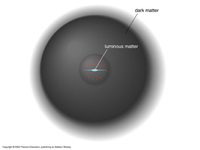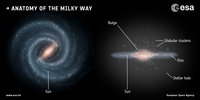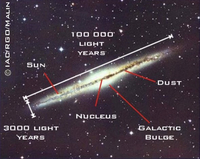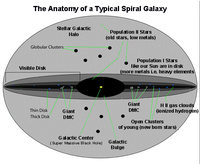The anatomy of a spiral galaxy like our Milky Way
I use three diagrams and one picture to describe the anatomy of a spiral galaxy. The first figure shows the large dark matter halo, extending well beyond the stars (luminous matter). Dark matter also resides inside the inner sphere where the stars are.
Now we will focus only on the inner portions of a galaxy, consisting of stars, dust, and gas. The second figure is a simulation of our Milky Way from a face-on and an edge-on view. (These are not images because it is impossible to get a camera far enough away from the Milky Way to get a picture.) The galaxy contains over a hundred billion stars, none of which can be resolved at this resolution. There are 6 spiral arms (3 sets of two), which resemble bluish spiral clouds with bits of pink. The relative location of our Sun is shown. A halo of stars forms a sphere of individual stars plus globular clusters. The stellar halo is tenuous (vary few stars per volume) and the globular clusters, which almost look like individual stars, typically consist 100,000 stars. All stellar halo stars including those in globular clusters and the stars in the bulge are Population II stars. These stars are among the oldest in the galaxy, forming first in the galaxy and each containing only trace amounts of heavy elements (also known as metals). Population I stars such as our Sun have ten times as much metals and are only about half as old as the galaxy. Pop. I stars reside primarily in the spiral arm disks.
The third figure is a picture of an edge-on view of a galaxy similar to the Milky Way. It is annotated as if it were the Milky Way. Note: the dust lanes that weren’t as clearly presented in the previous figure. It takes a pulse of light 100,000 years to cross from one end to the other of the luminous portion of the galaxy. The spiral arm disks have two components: the thin and thick disks. Crudely, the thin disk is the same thickness as the dust and the thick disk is more tenuous, extending above and below the plane defined by the thin disk. The Bulge of the Milky Way is somewhat smaller than most bulges.
The fourth diagram pull the entire central portion of the galaxy together, adding the supermassive black hole (SMBH) at the center, giant DMC (dark molecular clouds), open clusters of stars, and clouds of ionized hydrogen. Giant DMCs typically have masses in gas and dust equivalent to the mass of thousands of stars and are so dense that only radio and far-infrared wavelengths can be used to probe these. DMCs are where most star formation is occurring. While globular clusters consist of large numbers of old stars, open clusters are less well organized and consist of very young, newborn stars. Open clusters typical contain only 10-30 stars. In the outer most portions of the luminous galaxy and somewhat beyond are clouds of H II gas (ionized hydrogen gas.) H II clouds are difficult to observe, but there are also H II gas in the form of fountains and clouds extending into the stellar halo.
As you can see, galaxies form a complex ecosystem, which evolves over time.

Enjoy being online again!
Welcome to the community of good people who base their values on evidence and appreciate civil discourse - the social network you will enjoy.Create your free account
Enjoy being online again!
Welcome to the community of good people who base their values on evidence and appreciate civil discourse - the social network you will enjoy.Create your free account










